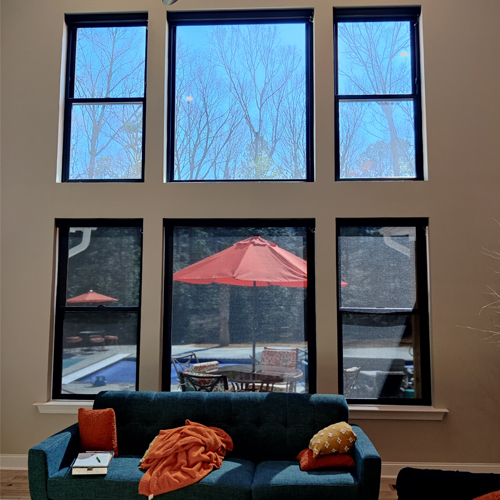Exactly How Residential Window Tint Improves Your Home's Aesthetic Charm
Exactly How Residential Window Tint Improves Your Home's Aesthetic Charm
Blog Article
Exactly How Residential Window Tinting Enhances Your Home's Energy Performance
Residential window tinting provides a compelling remedy for house owners looking for to boost energy performance within their living areas. By applying specialized movies to home windows, it successfully lowers warm transfer, thereby maintaining indoor temperature levels and minimizing the need for extreme heating or air conditioning.
Recognizing Home Window Tinting
Comprehending home window tinting is important for home owners seeking to enhance both comfort and energy efficiency in their living spaces. Residential Window Tint. Home window tinting entails the application of a slim movie to the inside or exterior surface area of glass windows. This film can substantially regulate the quantity of sunlight and warm that goes into a home, therefore influencing indoor climate problems
There are various sorts of home window tinting films offered, each with distinctive residential properties. For example, dyed movies absorb solar power, while reflective films deflect it away from the glass surface area. Ceramic movies supply an equilibrium of exposure and heat being rejected, making them a preferred selection amongst house owners. The efficiency of window tinting is commonly measured by its Visible Light Transmission (VLT) percent, which suggests how much light can go through the movie.
Advantages of Energy Performance
Window tinting not just improves looks but also plays a substantial duty in improving power effectiveness within residential areas. By lowering heat transfer via windows, colored films develop a much more secure indoor environment, which can lead to considerable reductions in energy intake for cooling and heating. This energy effectiveness translates into reduced utility costs, supplying homeowners with considerable lasting cost savings.

In addition, window tinting enhances the convenience of living rooms. By minimizing glare and blocking unsafe UV rays, tinted windows produce a more enjoyable environment, which can result in boosted wellness for occupants. The defense versus UV rays also aids maintain furniture and floor covering from fading, adding to the longevity of house items.
How Tinting Functions
Tinting films run through a mix of advanced products and innovations developed to regulate the amount of solar power going into a home. Primarily made up of polyester, these films usually integrate metal or ceramic bits that reflect and take in warmth. This dual capability permits them to substantially reduce the penetration of ultraviolet (UV) rays and infrared radiation while permitting visible light to pass through.
The efficiency of home window tinting is measured by its solar warmth gain coefficient (SHGC), which suggests just how much solar power is sent through the home window. Reduced SHGC values are more suitable as they represent better warm denial. Additionally, home window colors can feature a range of shades, permitting property owners to tailor their aesthetic choices while improving energy efficiency.
In addition, these movies work as a barrier, stopping warmth loss during colder months by reflecting interior warmth back into the home. This thermal insulation result enhances the air conditioning advantages gained during check warmer months, contributing to a balanced indoor climate year-round. By handling solar power properly, residential window tinting not just boosts comfort but likewise plays an important function in minimizing energy usage and reducing energy bills.
Selecting the Right Tint

There are various kinds of home window films available, consisting of dyed, metalized, and ceramic. Colored movies are affordable yet might have limited durability. Metalized films supply better warm denial however can hinder electronic signals. Ceramic films give excellent warm control without endangering visibility and are extremely sturdy, making them a popular choice.
Noticeable light transmission (VLT) is an additional essential element, as it suggests the amount of all-natural light that can go through the colored glass. Home owners should select a color with a VLT that matches their illumination choices while still this link supplying appropriate glow decrease.
Additionally, examining the solar warm gain coefficient (SHGC) can assist figure out exactly how well a tint can block warm from sunlight. A lower SHGC indicates better heat control, ultimately improving power effectiveness.
Installation and Upkeep Tips
Correct installment and maintenance are vital elements in making best use of the advantages of domestic window tinting. Experts additionally utilize specialized devices and techniques, which can boost the toughness and effectiveness of the color.
Complying with setup, upkeep is essential to extend the life of the window movie. It is advised to wait at the very least 30 days before cleansing the colored home windows to permit the adhesive to cure fully.
In addition, normal inspections are useful. Inspect for any kind of peeling or bubbling, which can suggest incorrect installment or put on over time - Residential Window Tint. Attending to these concerns without delay can prevent more damage and preserve energy efficiency. By adhering to these installation and maintenance suggestions, house owners can guarantee their window tinting remains to give substantial power financial savings and convenience for many years ahead.
Final Thought
In final thought, residential window tinting offers as an effective remedy for boosting energy effectiveness within homes. home By reducing warm transfer and obstructing unsafe UV rays, home window movies contribute to reduce power consumption and enhanced indoor comfort.
Window tinting entails the application of a thin film to the inside or outside surface area of glass windows. By minimizing warm transfer through home windows, tinted films produce a more steady interior environment, which can lead to significant reductions in power usage for home heating and cooling.The effectiveness of window tinting is gauged by its solar warmth gain coefficient (SHGC), which shows exactly how much solar power is transmitted through the window. By handling solar power effectively, property home window tinting not just boosts convenience but also plays an essential function in lowering power intake and decreasing energy bills.
By minimizing warmth transfer and obstructing harmful UV rays, window films contribute to lower energy usage and enhanced indoor comfort.
Report this page